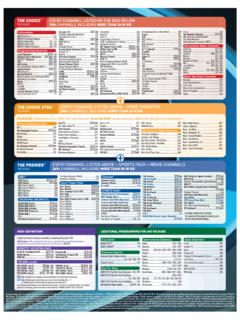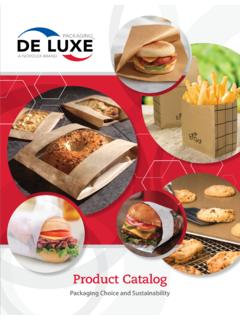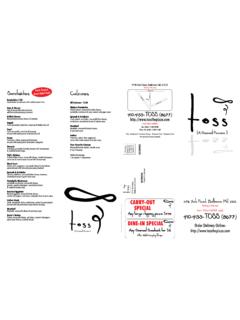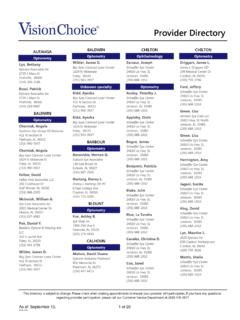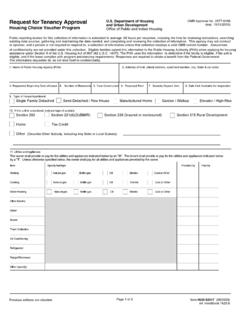Transcription of Farmer’s Choice Pig Management Manual
1 FARMER S Choice 1 Quality Meat ProductsFarmer s ChoicePig Management ManualFarmer s Choice House Management Manual Farmer s Choice Ltd. April 2011 Published by Farmer s Choice Box 47791-00100 Nairobi, KenyaTel: + 254 (0)20 8711722, 8711180-85, 8710416-9 Fax: + 254 (0)20 8712123, 8711146 Email: byDr. Vetr. MedicinePreben ToftemarkAll rights of this Manual are reserved. Do not reproduce, store in retrieval system, transmit in any form or by any means, electronic, graphic, mechanical, photocopy, recording or otherwise any part and or this entire book without prior written permission of the publisher. Table of contentsChapter 1 Farrowing House Management ..4 Chapter 2 Weaner House Managemet ..8 Chapter 3 Dry Sow House Management ..11 Chapter 4 Fatteners House Management ..12 APPENDIX 1 Scoring system for selecting sows (intending to be gilt/ boar mother ..14 APPENDIX 2 Vaccination Scheme ..154 FARMER S CHOICEFARROWING HOUSE MANAGEMENTTo have success in farrowing-in house you need to take stock in dry sow houses before arrival of the pregnant sows in farrowing pens.)
2 Look for body performance and if in a group of sows there are some with poor and down trodden condition, they should be removed and properly fed to do the best preparation for farrowing. Arriving to farrowing pens should take place 5-6 days before delivery to help them acclimatize and get used to lactating to reduce stress, normally high pregnant sows look for isolation. The pen should be well prepared, white washed and disinfected. Ensure the white wash is totally dry- because the sows can be skin burned. The movement of the high pregnant sows from dry sow houses should be done carefully. Most appropriate use guiding- boards and preferably done by staff from farrowing houses. Vaccination Scheme: About 3 weeks before delivery for sows and 3 to 6 weeks before delivery for gilts (parity 1).E- Coli and Clostridium, incase of threatening Atr. Rhinitis use because of endemic Ascaris infestation. It is advisable to deworm 1-2 weeks before delivery.
3 Before arriving to the cleaned pen, sows can get appropriately washed in temperature water to clean the body for worm the appetite is reduced before delivery. Don t overfeed, but be aware the sows need power to give birth and the piglets need some power to struggle for life. It may be advisable for some poor performance sows, to add a little creepers delivery should be observed but not disturbed. When the last born piglet is getting dry or the interval is about an hour, then it is time for taking action. All approaches to a delivering sow should be done very carefully and only by well trained staff. Take time to approach the sow, give some very soft massage on the udder, it stimulates contractions in the uterus and works better than Oxytocin. After communicating with the sow, clean your hands and the external birth canal. Use a lot of lubrication and insert your arm in the birth- 1 FARMER S Choice 5 Extract as many piglets as possible and leave some lubrication inside the uterus (womb).
4 After birth assistance, direct the piglets to the udder and stimulate by massage to lay -down milk and further uterus contractions. When birth assistance fails because no piglets can be reached, then let the sow move slowly down the corridor and back again. The movement should be done with great patience because most sows don t like to leave the farrowing environment. After some movement, most dislocations of the uterus will take its natural place and after some relaxation, the delivery will carry important after farrowing, is to observe the piglets. If they are hungry, restless and look freezy, then the sow may have problems related to the udder (Mastitis). Call your veterinarians and get the sow properly examined. If the piglets have already developed dehydration, then immediately use temperature electrolytes 6 FARMER S CHOICEby drinking. There may be some discharge from the sow after delivery- it is normal, but if the discharge looks inammatory, alert your veterinarian and take action.
5 It is all about the comfort of the sow and later reproductive performance. Because the piglets are born with very little iron- deposit, it is necessary to inject 150-200mg iron on the 2nd or 3rd day (providing the red- corpuscles for oxygen transportation) if the piglets look pale. Later while suckling, the treatment can be of ambiguous prevalence of coccidiosis oocysts (causing diarrhea), it is advisable to treat the piglets with Baycox through its mouth on the 3rd day after birth. Ensure the drug is placed on the tongue and not in the wind most appropriate time for weaning should take place at 35 days of age. Move the sows to service houses, keep them in stable groups. Weaners should be kept properly- warm and dry. Weaners should be transferred to weaners accommodation by some cages or small wagons to avoid contact with contaminated corridors. Reasons for culling sows instead of transfer to service:1. Poor performance concerning litter size (productivity)2.
6 Poor milker because of mastitis and loss of productive teats3. Lameness because of bad trotters and arthritis4. High parityFostering SchemesMain target to provide survival for as many piglets as possible. At first, look for suitable fostering mothers as close to orphans as possible. Try to assure that the piglets intending to get moved if possible have got some colostrum from the mother. After getting a suitable fostering mother, don t remove all her piglets, let at least 4-5 piglets stay, the smallest. If possible look for low parity sows for fostering. Protect the piglets not to get crashed. Implement of crashed bars along the wall in farrowing pens can highly be recommended. Most important in farrowing houses, Tender, Loving S Choice 78 FARMER S CHOICEWEANER HOUSE MANAGEMENTWhat time (age) to wean? It depends on accommodations for the weaners just from high expensive incubators, very expensive feeds and sow reproduction.
7 Local conditions, climate weaners facility and cost of feed are indicating the most optimal time for weaning will be in the age of 5 little calculation useful to understand:We calculated pregnancy in about 118 days. The lactation as suggested in 35 days, the days between weaning and service average 7 out of 160 days. 360 days (1 year) divided by 160 = that means liters per sow per year. With time, I suppose this number can be increased a little approaching to and following around 5 litres per sow per two (2) years, ( hopefully resulting in 50 fatteners per sow per two (2) the pregnant sow needs some days to acclamatize to farrow pen conditions and the pens need some cleaning, disinfection and dryness. The following calculation is useful: 1 week to prepare the farrow (pen) 5 weeks of lactation. It gives a total of 6 weeks, which a sow needs, times a year that means 13 weeks per sow per year. 52 weeks (Year) divide by 13-4 that means one farrow-pen can accommodate 4 sows per year if properly organized.)
8 This calculation should be useful as a framework for weekly service weaning induces estrus, when well managed, this can guarantee a uniform number of sows serviced per week, which would then relate to the number of sows per farrowing pen per year. Weaning piglets should be done properly without unnecessary stress preferably transported in cages without contact to contaminated corridors. The weaner house should be properly cleaned (disinfected) and totally well dried. Wooden floor, some covering (roof ), curtains in front of the roof for the first week preferably, access to temperate water and no access to cold water feeding 4 times a day and high hygiene. Because of high risk for diarrhea, add some fiber (crusted oat) and to improve intestine mucosa and reduce scour then add some Zinconxyd. (3-4) gram per kg total feed) and only for the first 10 days after weaning. Be aware of the hygiene. After cleaning, use a little stalosan especially in wet 2 FARMER S Choice 910 FARMER S CHOICEK eeping the weaners in high hygienic environment is basis for optimal feed conversion and crucial for later fatteners is highly advisable to move weaners or fatteners as little as possible.
9 Every movement means loss of daily gain and feed. Wean in bigger groups and divide them later (small and big). There may be some unused potential in the system called all in or all out from weaning to S Choice 11 Dry- Sow House ManagementWean the sows in stable groups, most practical give the intended group of sows a colour mark (green, red etc|) before leaving farrowing houses. Group depending on performance, age (parity) and health. The more uniform the better. Be aware of aggressive boar contact before the third (3) day after weaning. Boar contact by nose only from day 3 use the boar as indicators for estrus. Do the service with assistance from boar-nose- contact. After service, use the boar daily to control nose- contact from corridors, still keep sows in stable groups, two times return from estrus means culling. It is advisable to keep weaned sows in separate small pens , comfortable for standing, eating and sleeping.
10 It means no stress, individual feeding, boar nose- contact, proper service and optimal conditions for fertilizing eggs and estimated number of embryos. In terms of bio- security, it is highly advisable to feed pregnant sows with a little grass or hay daily (vitamins and minerals as well as fibres).Vaccination Schemes: 6 and 3 weeks before farrowing for gilts and 3 weeks before for sows. Deworm around 1-2 weeks before 312 FARMER S CHOICEFATTENERS HOUSE MANAGEMENTThe most appropriate way of housing for the fatteners should be kept in sections for all out or all in. Before arrival of big weaners, the pens should be cleaned, disinfected, whitewashed, totally dry and empty for one week. Arrival to fatteners houses can be done in groups of small weaners depending on the pen construction. If wooden floors and some roofing are available, bigger groups can be housed together and later divided into neighbor comfort zones is a very important object because of feed/convert.
